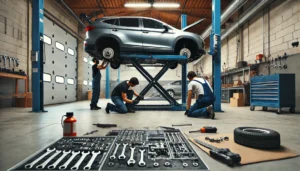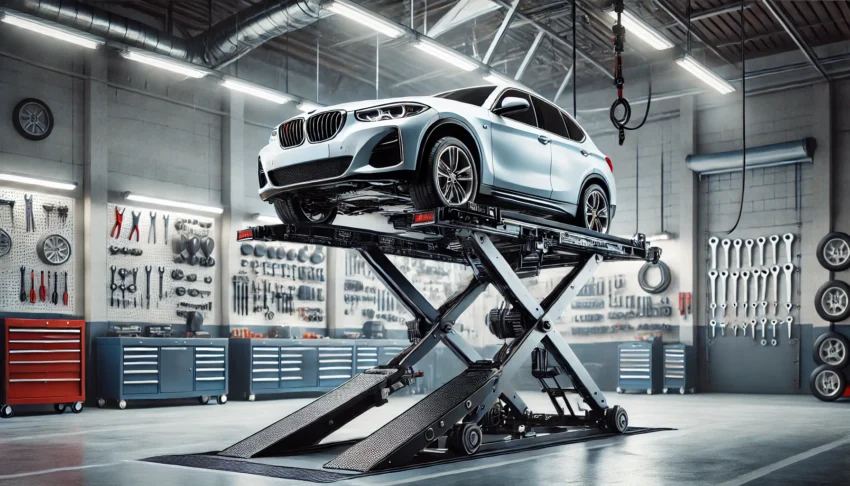If you’re in the automotive repair business or even an avid DIYer with a garage, chances are you’ve considered purchasing an automotive scissor lift. But what exactly is it? An automotive scissor lift is a piece of equipment designed to raise a vehicle into the air, allowing for easy access to the underside. These lifts are commonly found in auto repair shops and garages, where they play a crucial role in everything from routine maintenance to major repairs.
Not only do they make life easier by reducing the physical strain of working on a vehicle, but they also add a level of efficiency and safety that’s hard to beat. In this article, we’ll dive deep into the world of automotive scissor lifts—exploring how they work, their benefits, and why they are essential in modern-day garages.
Types of Automotive Scissor Lifts
Before choosing the right scissor lift for your garage, it’s important to know the different types available on the market. Each type comes with its unique mechanism and purpose.
Hydraulic Scissor Lifts
The most common type of scissor lift, these work through a hydraulic system that compresses and lifts the vehicle. They’re renowned for their durability and smooth lifting action.
Electric Scissor Lifts
Electric lifts use a motorized system to raise and lower the platform. These are quieter and more energy-efficient but may not lift as heavy loads as their hydraulic counterparts.
Pneumatic Scissor Lifts
Pneumatic lifts use compressed air to operate. Though less common, they are ideal for environments where electricity might pose a safety hazard or isn’t easily available.
How an Automotive Scissor Lift Works
An automotive scissor lift operates through a series of interlocking supports that compress or extend vertically. Picture a pair of scissors: when you open and close them, the blades move closer or farther apart in a scissor-like motion—hence the name. These mechanisms, combined with a power source (hydraulic, electric, or pneumatic), create the force needed to lift heavy vehicles.
The platform that supports the vehicle is generally wide and sturdy, designed to handle various vehicle sizes. Load capacities vary depending on the model, but most automotive scissor lifts can hold anywhere from 3,000 to 12,000 pounds.
Key Features of Automotive Scissor Lifts
Compact Design
One of the biggest selling points of a scissor lift is its compact design, making it perfect for smaller garages with limited space.
Weight Capacity
The lift’s ability to carry weight is one of its core features, ranging from lighter-duty lifts for smaller cars to heavy-duty lifts for large trucks.
Adjustable Height
The height of the lift can be easily adjusted to accommodate various types of work, making it versatile for both low-clearance cars and larger SUVs.
Advantages of Using Automotive Scissor Lifts
Automotive scissor lifts come with a range of benefits, making them a go-to choice for professionals and home mechanics alike.
Space Efficiency
Because they lift vehicles vertically and have a compact footprint, scissor lifts save a lot of space in comparison to other types of vehicle lifts.
Safety Enhancements
Working under a vehicle raised by a scissor lift is significantly safer than using a jack and stands. These lifts are designed with fail-safes and locking mechanisms to prevent accidents.
Increased Productivity
In a busy garage, time is money. Automotive scissor lifts speed up processes like tire changes, brake work, and oil changes, allowing mechanics to work more efficiently.
Common Applications of Automotive Scissor Lifts
Use in Repair Shops
The most common use for scissor lifts is in professional auto repair shops. They are vital for any job that requires access to a car’s underside.
Vehicle Inspections
When inspecting a vehicle for issues like rust, oil leaks, or damaged parts, scissor lifts offer clear access to the undercarriage.
Tire and Oil Changes
Quick and frequent jobs like tire rotations or oil changes are made much simpler with a lift that can quickly raise and lower a car.
How to Choose the Right Scissor Lift for Your Garage
Evaluating Load Capacity
Always check the lift’s weight limit to ensure it can safely handle your vehicle.
Considering the Available Space
Measure your garage to confirm there’s enough room not just for the lift, but for working around it when a vehicle is raised.
Choosing Between Portable and Fixed Lifts
Portable lifts offer flexibility for garages that need to frequently move equipment around, while fixed lifts are more stable and better suited for high-volume shops.
Safety Tips for Using Automotive Scissor Lifts
Regular Maintenance and Inspection
Routine maintenance is crucial. Inspect the lift’s mechanical parts, especially the hydraulic or electric components, for any signs of wear.
Importance of Correct Load Distribution
Always center the vehicle on the lift to prevent uneven pressure, which could lead to accidents.
Following Manufacturer’s Guidelines
Each lift comes with specific instructions. Follow them to the letter to ensure safe and proper usage.
Installation and Setup of an Automotive Scissor Lift

Before setting up your lift, make sure the surface is level, stable, and capable of supporting both the lift and the vehicle’s weight. A solid concrete floor is ideal.
Pre-installation Requirements
Ensure you have enough space and that your garage’s electrical setup can handle the power requirements.
Step-by-Step Installation Guide
- Choose the lift’s location.
- Bolt the lift into place (if fixed).
- Connect it to power (for electric or hydraulic lifts).
- Test the system without a load first.
Common Installation Mistakes to Avoid
Make sure the bolts are tight, and all hydraulic lines are correctly sealed before using the lift.
Maintenance of Automotive Scissor Lifts
Daily and Weekly Checks
Perform routine checks on the lift’s structural components and hydraulic system.
Lubrication and Hydraulic System Care
Keep all moving parts lubricated and ensure that the hydraulic system is free from leaks.
Replacing Parts and General Servicing
Over time, some parts like seals, filters, and motors may need replacement. Follow the manufacturer’s guidelines for general servicing.
Common Problems and Troubleshooting
Issues with Lifting Speed
If the lift is rising slowly, check for hydraulic fluid levels or a weak electrical connection.
Troubleshooting Hydraulic Leaks
Hydraulic leaks are often the result of damaged seals. Replace them immediately to prevent further issues.
Electrical Problems in Electric Lifts
Electrical lifts may suffer from wiring problems or blown fuses, so check these areas if the lift won’t power on.
Costs of Automotive Scissor Lifts
The price of a scissor lift can vary depending on the type and size. Smaller, portable models may cost around $2,000, while heavy-duty models can go up to $10,000.
Initial Investment
Expect to spend at least a few thousand dollars on a quality lift, but the time and effort saved can make it worth the investment.
Ongoing Maintenance Costs
Maintenance costs are usually low, but replacing parts like hydraulic seals or motors will add up over time.
Factors Influencing Price
Load capacity, brand, and additional features (like portability) can significantly impact the price.
Top Brands of Automotive Scissor Lifts
Rotary Lift
Known for their durability and heavy-duty capabilities.
BendPak
BendPak offers a wide range of lifts, from entry-level models to high-end options.
Atlas Automotive Equipment
Atlas specializes in cost-effective solutions that don’t compromise on quality.
Future Trends in Automotive Scissor Lifts
As technology continues to advance, expect to see more smart lifts with automated systems and diagnostic tools. There’s also a growing demand for eco-friendly lifts that reduce energy consumption and environmental impact.
Conclusion
In today’s fast-paced automotive industry, having the right tools can make all the difference. An automotive scissor lift not only increases efficiency but also adds a layer of safety and convenience to any garage. Whether you’re running a professional repair shop or working on cars at home, investing in a scissor lift is a smart move that will pay off over time.
FAQs
How much weight can a scissor lift hold?
Most lifts range from 3,000 to 12,000 pounds, depending on the model.
What’s the difference between a scissor lift and a two-post lift?
Scissor lifts are more compact, whereas two-post lifts offer greater access underneath the vehicle.
Are scissor lifts safe for home garages?
Yes, they are designed for safety, provided they are used correctly and installed on a stable surface.
How long does an automotive scissor lift last?
With proper maintenance, a scissor lift can last up to 15-20 years.
Can you move a portable scissor lift easily?
Yes, portable models are designed to be moved, although they can be heavy and may require assistance.

